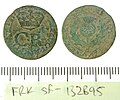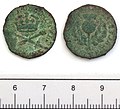This article needs additional citations for verification .(June 2014) |
A bodle or boddle or bodwell, also known as a half groat or Turner was a Scottish copper coin, of less value than a bawbee, worth about one-sixth of an English penny. They were first issued under Charles I, and were minted until the coronation of Anne. [1] Its name may derive from Bothwell (a mint-master). [2]
Contents
It is mentioned in one of the songs of Joanna Baillie:
Black Madge, she is prudent, has sense in her noddle
Is douce and respectit; I carena a bodle.
The use of the word survives in the anglicised phrase "not to care a bodle", [2] which Brewer glosses as "not to care a farthing". Something similar appears in Burns' Tam o' Shanter (line 110), it is also mentioned:
Fair play, he car'd na deils a boddle (He cared not devils a bodle)




